I was fortunate to have had optimistic role models during my formative years. They taught me that glass wasn’t either half empty or half full, because the glass can be refilled at any time.
They sang songs like, “Look for the Silver Linings when e’er a cloud appears in the blue; remember somewhere the sun is shining and that the right thing to do is make it shine for you.”
The song ends with, “So always look for the silver lining and try to find the sunny side of life.”
Some clouds are so small and wispy, we hardly notice them, but those big dark clouds that sometimes hang over a rare disease family will challenge us. We might want to give in to gloom and doom; our hearts are heavy as we squint to focus on the cloud’s lining. It can be very hard to be positive when you’re in the middle of a negative situation. I really don’t have anything positive to say about the way a rare disease ravages a person’s body.
However, I have nothing but positive praises for the people who are doing heroic jobs of living with rare diseases. They have brought many silver linings to my life.
Sometimes the silver lining is the lesson learned from going through an experience.
Sometimes simply getting on the other side of a tough situation is itself a silver lining.
I managed to pass this notion along to my daughter, whose rare disease warranted numerous operations.
She was about 12 years old when the resident who was in charge of her case happened to have a surly disposition. When I realized how difficult our interactions with him were becoming, I suggested to Kelley that we find a way to make him smile at least once before we left that hospital. I even bought a little plaque to put on her bedside table. It read, “If you see someone without a smile, give them one of yours.”
We both said some very silly things to him, trying to find his sense of humor. Kelley became quite cute and clever when responding to his questions. I don’t know if we had much of an impact on that man, but it made us feel so much better about his attitude when we saw these interactions as challenges and had fun with them.
Sometimes the silver lining to a particular situation doesn’t come into view until later on.
One time Kelley was in the hospital ready for surgery when the surgeon said he was concerned about the results of some of her blood tests. It was disappointing to be sent home and go back at a later date. However, after she did have that surgery, the anesthesiologist who saw her through a very difficult time, and stayed with her for many days after when, she was in Intensive Care, was the doctor who would make the connection with a surgeon to help her serious trachea problem. And we learned later that that particular anesthesiologist would not have been available if she had the surgery on the original date.
From the first time we connected with another family sharing the rare disease our daughter had, to the many connections since, we have had some very rewarding relationships born out of a desire to share. We often connect over the internet, but meet in person whenever possible. Those other families are truly silver linings!
So, let’s always keep looking for silver linings and trying to find the sunny side of life.

Share this rare disease story and let us know your rare disease experience today.






